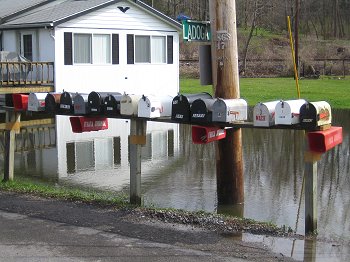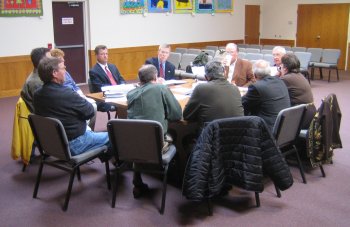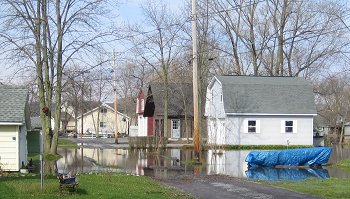- By Dan Veaner
- News
 Print
Print
Dearth of Data Plagues Sewer Committee
Lansing's sewer committee met Wednesday to ponder challenges the project faces before a vote that is currently planned for September. They discussed a wide range of ongoing issues including financing, zoning and land use, expanding the initial service area, the formula for calculating landowners' costs, and getting the facts about current septic problems, replacement costs, and testing.

Several yards like this one were covered with water at
Ladoga Park when this picture was taken yesterday.
The committee has been frustrated by a lack of hard data to support their concern that septic systems in Lansing are inadequate, compromised, and on many plots of land, irreplaceable. Stearns and Wheler engineer Jim Blum was working on a study of land conditions as they would affect various neighborhoods in the town and the cost ranges of replacing them based on local contractor pricing. Blum accepted a position at Syracuse University before the study was completed, but it is being continued by his replacement William Hall along with Town Engineer David Herrick.

Lansing Sewer Committee
Over a five week period in October and November last year the Tompkins County Health Department conducted dye tests at 16 of the 25 homes in Ladoga Park, Lansing's most notorious neighborhood for flooding when the water level in Cayuga Lake is high. John Anderson, who was the Director of Environmental Health Services at the time, sent a letter to committee chairman Bud Shattuck last month with the department's findings that none of the septic systems released dye into the lake.
"However, this does not mean that all or even any of the tested systems are functioning satisfactorily," Anderson continued. "A negative dye test is not proof of satisfactory operation."
Anderson went on to list four key negative aspects of septic systems on the lots, saying that all the lots were in the 25 year flood zone, and that lots there are not big enough to meet federally defined wetland regulations. Committee members noted that dye tests under ideal conditions will provide negative results, so it is important to test at different times of year under different conditions, including the worst conditions. Those conditions exist now, with serious flooding in the neighborhood, but testing is not being conducted there.
Hall was critical of the letter. "They say, 'Only two lots exceed the half-acre minimum required for a new sewage system and many are under 1/4 acre,'" he said. "That doesn't seem so bad. What they should have said is 'only two of 25 lots meet the minimum 1/2 acre required for a new septic system.' It would have been a lot stronger. Only two lots meet the minimum requirements today. If they were being built today they couldn't have done it."

Much of the Ladoga Park road is under water, as are many
of the yards and their accompanying septic systems.
Committee member Nick Berra said that Ladoga Park residents can't currently flush their toilets, because their septic systems are currently under water. "Finally it's going to take somebody to say enough is enough" said committee member Rich Farr. "What's going into this lake has got to stop. What's the trigger going to be? What does that water look like right now, today? Who drinks it?"
The lack of solid data showing environmental problems is the number two challenge facing the committee, after the issue of cost. Many said that common sense shows there is a problem, but it is refuted by project opponents because of the lack of solid data.
Months ago Anderson had promised an analysis of Health Department records showing the number of 'compromised systems' in Lansing, septic systems that do not meet code but are accepted because an existing lot is not big enough to meet today's regulations. To date Shattuck says the committee does not have the analysis.
Some committee members lamented that the Tompkins County Health Department does not conduct stringent testing and enforcement as Cayuga County does. Town Councilwoman Connie Wilcox noted, "That is part of the public outcry (against the sewer project) because there is nothing from the Health Department that is strong enough."
The top challenge the committee faces is money. With estimates of costs to homeowners who are hooked up to the system at over $800 per year, all agree it is too much. A subcommittee continues to solicit grants from private sources, and attorney Mary Chappell reported progress in obtaining favorable loans from the EPA's Rural Development Loans and Grants Program.
A point of disagreement between the Town and Village of Lansing continues to haunt the committee. With the Village wanting to own the part of the trunk sewer that passes through its territory, Noel Desch brought the Town's ability to recover the expense, especially from not-for-profit organizations within the sewer district. Shattuck said the issue would be passed to Town Attorney Guy Krogh for analysis.

Bill Hall joins the Lansing project as the 'face' of the
Stearns & Wheler, LLC engineering team.
Hall was a surprise addition to the committee. The company's Vice President Howard LaFever introduced Hall, explaining that since the last meeting it was found that Tim Taber, who had been assigned two weeks ago to replace Blum on the Lansing project, had scheduling conflicts with other projects. "Bill is one of the few people in our company who has been here longer than I have," LaFever said. "Close to 40 years. Bill has done a lot of infrastructure work, and he's been involved with putting together and financing and oversight for a lot of infrastructure in five or six towns and a couple of villages north of Watertown."
----
v3i16
Lansing's sewer committee met Wednesday to ponder challenges the project faces before a vote that is currently planned for September. They discussed a wide range of ongoing issues including financing, zoning and land use, expanding the initial service area, the formula for calculating landowners' costs, and getting the facts about current septic problems, replacement costs, and testing.

Several yards like this one were covered with water at
Ladoga Park when this picture was taken yesterday.
The committee has been frustrated by a lack of hard data to support their concern that septic systems in Lansing are inadequate, compromised, and on many plots of land, irreplaceable. Stearns and Wheler engineer Jim Blum was working on a study of land conditions as they would affect various neighborhoods in the town and the cost ranges of replacing them based on local contractor pricing. Blum accepted a position at Syracuse University before the study was completed, but it is being continued by his replacement William Hall along with Town Engineer David Herrick.

Lansing Sewer Committee
Over a five week period in October and November last year the Tompkins County Health Department conducted dye tests at 16 of the 25 homes in Ladoga Park, Lansing's most notorious neighborhood for flooding when the water level in Cayuga Lake is high. John Anderson, who was the Director of Environmental Health Services at the time, sent a letter to committee chairman Bud Shattuck last month with the department's findings that none of the septic systems released dye into the lake.
"However, this does not mean that all or even any of the tested systems are functioning satisfactorily," Anderson continued. "A negative dye test is not proof of satisfactory operation."
| ""Finally it's going to take somebody to say enough is enough. What's going into this lake has got to stop. What does that water look like right now, today? Who drinks it?" - Richard Farr |
Anderson went on to list four key negative aspects of septic systems on the lots, saying that all the lots were in the 25 year flood zone, and that lots there are not big enough to meet federally defined wetland regulations. Committee members noted that dye tests under ideal conditions will provide negative results, so it is important to test at different times of year under different conditions, including the worst conditions. Those conditions exist now, with serious flooding in the neighborhood, but testing is not being conducted there.
Hall was critical of the letter. "They say, 'Only two lots exceed the half-acre minimum required for a new sewage system and many are under 1/4 acre,'" he said. "That doesn't seem so bad. What they should have said is 'only two of 25 lots meet the minimum 1/2 acre required for a new septic system.' It would have been a lot stronger. Only two lots meet the minimum requirements today. If they were being built today they couldn't have done it."

Much of the Ladoga Park road is under water, as are many
of the yards and their accompanying septic systems.
Committee member Nick Berra said that Ladoga Park residents can't currently flush their toilets, because their septic systems are currently under water. "Finally it's going to take somebody to say enough is enough" said committee member Rich Farr. "What's going into this lake has got to stop. What's the trigger going to be? What does that water look like right now, today? Who drinks it?"
The lack of solid data showing environmental problems is the number two challenge facing the committee, after the issue of cost. Many said that common sense shows there is a problem, but it is refuted by project opponents because of the lack of solid data.
Months ago Anderson had promised an analysis of Health Department records showing the number of 'compromised systems' in Lansing, septic systems that do not meet code but are accepted because an existing lot is not big enough to meet today's regulations. To date Shattuck says the committee does not have the analysis.
Some committee members lamented that the Tompkins County Health Department does not conduct stringent testing and enforcement as Cayuga County does. Town Councilwoman Connie Wilcox noted, "That is part of the public outcry (against the sewer project) because there is nothing from the Health Department that is strong enough."
The top challenge the committee faces is money. With estimates of costs to homeowners who are hooked up to the system at over $800 per year, all agree it is too much. A subcommittee continues to solicit grants from private sources, and attorney Mary Chappell reported progress in obtaining favorable loans from the EPA's Rural Development Loans and Grants Program.
A point of disagreement between the Town and Village of Lansing continues to haunt the committee. With the Village wanting to own the part of the trunk sewer that passes through its territory, Noel Desch brought the Town's ability to recover the expense, especially from not-for-profit organizations within the sewer district. Shattuck said the issue would be passed to Town Attorney Guy Krogh for analysis.

Bill Hall joins the Lansing project as the 'face' of the
Stearns & Wheler, LLC engineering team.
Hall was a surprise addition to the committee. The company's Vice President Howard LaFever introduced Hall, explaining that since the last meeting it was found that Tim Taber, who had been assigned two weeks ago to replace Blum on the Lansing project, had scheduling conflicts with other projects. "Bill is one of the few people in our company who has been here longer than I have," LaFever said. "Close to 40 years. Bill has done a lot of infrastructure work, and he's been involved with putting together and financing and oversight for a lot of infrastructure in five or six towns and a couple of villages north of Watertown."
----
v3i16



